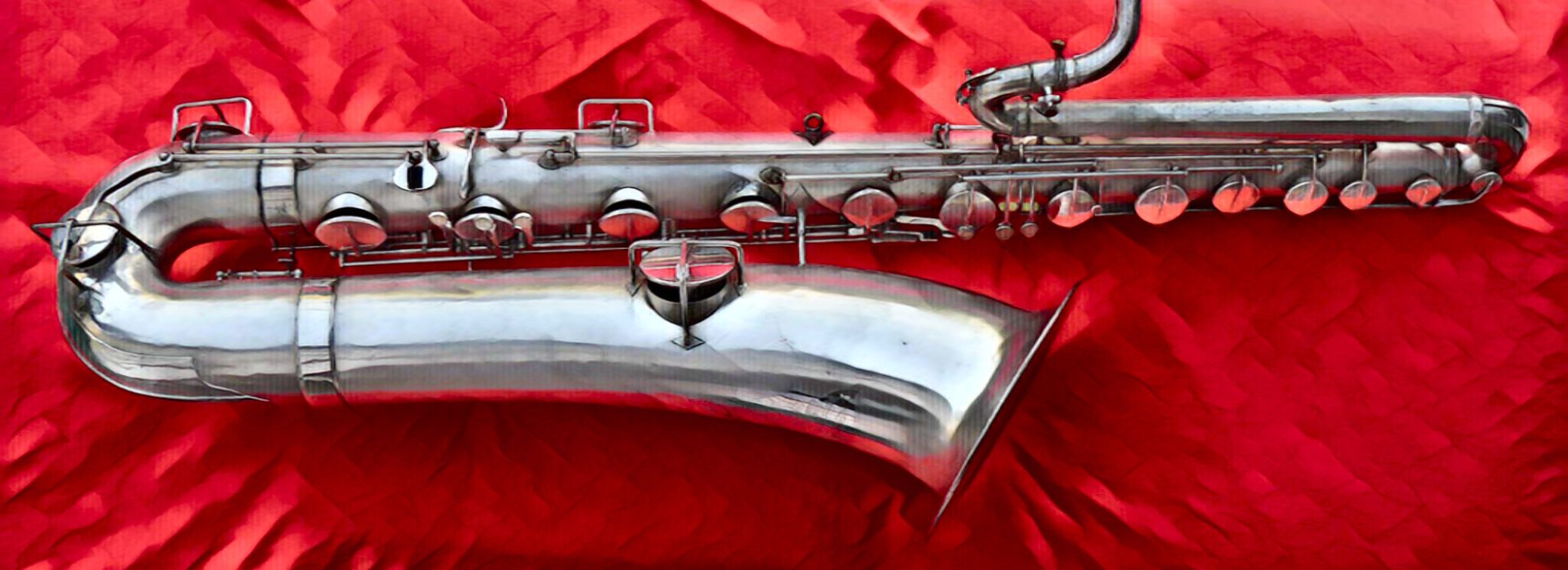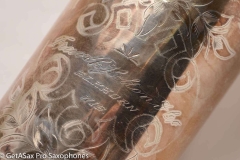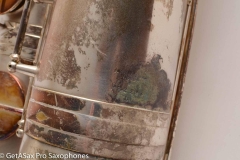
Stencil saxophones: What are they?
Very simply put, a stencil saxophone is a horn that was made by one of the major manufacturers for another company or perhaps a music store. This is as true today as it was in the day when today’s vintage horns were new.
The ordering company would then have their name engraved, or “stenciled”, on the saxophone, and then the horn was sold without any reference to the actual manufacturer. Oftentimes the major manufacturers would alter their main line of instruments slightly for their stencil productions—depending on what the ordering company wanted.
When discussing vintage saxophones, American and European saxophone manufacturers were for the most part, all involved in manufacturing stencil horns for others. One company that NEVER made stencil saxophones was Selmer Paris.
What’s a stencil sax look like?
Sometimes the stencil horns were pretty stripped down, and didn’t have fancy finishes such as silver and gold plate, rolled tone holes (in the case of Conn), mother of pearl on their keys, or keys like the front F, fork Eb, or G# trill key. Other times, the ordering company wanted their stencil saxes to have all the bells and whistles, and be gold plated. When it comes to vintage stencil saxophones, they really were all over the map.
To a large degree the variance in vintage stencil saxophones is determined by where they originated from. Vintage American saxophones were usually made by:
- Buescher
- Conn
- Martin
- Holton
- King
However, the last two—Holton and King—only occasionally produced stencil horns.
American vs. European stencils horns
When the US manufacturers made stencil saxes, the horns tended to be of the more stripped-down variety. In some cases, these US stencils were made with cheaper materials than their name brand counterparts, therefore they tended to be of a lesser quality as well.¹
Oftentimes the stencil saxophones designs were based on discontinued, but modified versions of pro horns. For example, the original Selmer Bundy saxophones, were Buescher True Tones with left-sided bell keys. The serial numbers on US stencil saxophones tended not to follow the numbering charts for the pro horns from the same manufacturer.
When a stencil saxophone originated in Europe, it generally was not of a stripped-down variety. For the most part, European stencil saxophones were offered with the same features as the horns they were stencilled from. Where they differed however, was in the engraving and usually in the number of finish options available.
More often than not though, the serial numbers of the European stencil horns followed in sequence with those of the name brand horns—meaning the serial number charts of European horns usually apply to stencils horns as well. EG: If you are looking for the year your Keilwerth or Kohlert stencil sax was made, you can follow the published serial number charts to find out.
European stencil manufacturers included
- Amati (Czech)
- Beaugnier (French)
- Couesnon (French)
- Dörfler & Jörka (German)
- Evette & Schaeffer, Buffet-Crampon (French)
- Hammerschmidt (German)
- Keilwerth (German/Czech)
- Kohlert (German/Czech)
- Orsi (Italian)
- Pierret (French)
- SML (French)
Stencil saxophones are usually called by the name of the manufacturer, for example a Conn stencil, or Hammerschmidt-stencilled Hüttl.
An important thing to remember is that the ordering companies quite often switched stencil manufacturers–many times for financial reasons. For example, I found a German interview with Gerhard Keilwerth, in which he was asked if Keilwerth made Voss saxophones, and why there was such a difference in the quality of the stencil brand. Gerhard Keilwerth explained that during the 1950s Voss had Keilwerth build only a handful of horns for them, because in the end the JK horns were just too expensive. Voss switched to Dörfler & Jörka for their stencil horns, because the D&J horns could be had for less. Later Voss bought their stencils from a company in East Germany.
Second-line saxophones: what’s the difference?
It is worth noting that the term “stencil” horn has changed over time, and has evolved to take in second-line horns like Conn’s Pan American line of saxophones. This is not an accurate use of the term stencil sax. Second-line horns are really student or intermediate level horns made and sold by major saxophone manufacturers under a separate name. This chart shows the American saxophone makers along with their second-line names.
Manufacturer |
Second-line name |
Budget line of Second line |
Conn |
Pan American |
Cavalier |
Buescher |
Elkhart |
|
Martin |
Indiana |
|
King |
Cleveland |
- In the case of Buescher, Martin, and King, the names of their second-line instruments—Elkhart, Indiana, and Cleveland respectively—came from the the company that the main company bought out.
- With regards to the Pan American, over the course of it’s production run it underwent a significant change. In the beginning it was not unusual to find a Pan American saxophone with the same body tube as a Conn New Wonder. For example, if the rolling of the tone holes did not turn out 100% correctly, the sax would become a Pan American. Over time however, Pan American became their own entire line, complete with their own patented tone hole layout. 2
Stencils of second-line saxophones
Some manufacturers, Conn comes to mind, made stencils of their second-line saxophones. Specific to Conn, while not all Pan American saxophone, nor their stencils, start with the letter “P” in their serials, many do.
It is not unusual to find Conn stencils of all sizes and shapes that start with a “P”, or not, and have the Conn patent, such as this Holton bass. (See below for patent links and details.)
The takeaway is simply this: Look at the patent number and it will tell you if you are looking at a stencil of a Conn, or of a Pan American.
Links to other articles on stencil saxes
If you are interested in Conn or Pan American saxophones, check the Conn Loyalist site.
For what is arguably the most comprehensive online list of stencil saxophones, check out my Stencil Saxophone Names & Links page. It’s a searchable database of stencil, second, third, and in some cases even student model horn names, along with the manufacturers who made them. More refinements and additions are coming, but for now it is good to go.
For more information on how to identify your vintage stencil saxophone, check out this article by Dr. Rick.
Cybersax also had some very interesting information on stencil saxophones that might be worth checking as well. (The link I provided is thru the Wayback Machine.)
One thing I should mention is that both Dr. Rick’s and late Bear’s resources really focus on American stencils only. If you’re looking for help in identifying your vintage European stencil horn, you’re not going to get specific brand assistance on either site. However, some of the general information might be useful to help you determine what you should be looking for in helping identify the manufacturer.
1 Adapted from Pete Hales’ article, Stencils and “Second Line” Models, published on Sax On The Web.
2 The patent for Pan American horns is: 1153489, and was issued on Sept. 14, 1915. The patent for Conn’s is: 1119954, and was issued Dec. 8, 1914.



